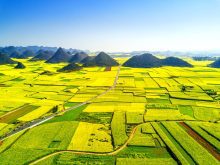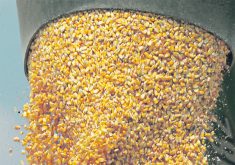After 15 years in the sheep business, Randy Smith has never seen lamb prices so high.
A combination of increased consumer demand and a smaller Canadian flock because of BSE and drought have combined to force prices higher. Prices show no sign of falling.
“Lamb markets are really good,” said Smith, procurement manager for Sunterra Meats in Innisfail, Alta.
Rail grade prices at the central Alberta plant are $2.65 a pound. About 55 percent of the lambs are also meeting Sunterra’s lamb meat grid, boosting the price to $3.02 per lb.
Read Also

Chinese, Indian tariffs take toll on pea prices
The disruption of pea exports from Canada’s largest customers will likely result in slow pea exports for the remainder of the crop year.
The last time prices were strong was before BSE was discovered in a northern Alberta cow and the border to the United States was still open to Canadian sheep and lambs.
The base rail price for lambs in early February 2003 was about $2.35. In April that year, lamb prices ranged from $2.50-$2.60.
“That was shaping up to be a record year at that time,” said Bob Pettie, also of Sunterra.
By June of 2003, after BSE was confirmed and the border closed, prices had dropped to $2 to $2.10 per lb. when more than 60,000 lambs that normally were exported to the United States flooded the Canadian market.
Lambs going to market now are considered old crop lambs from last year. There are traditionally few lambs ready for sale at this time of year. Prices usually start to drop by June after the Easter market peak and before the new crop lambs come on the market.
Dave Atsma, owner and manager of Camrose Auction, said prices at his sale Feb. 11 were strong with too few sheep for the three main buyers. At the sale, 70-80 lb. lambs brought $1.45-1.55 per lb. Lambs 90-100 lb. brought $1.20-$1.35 while fat lambs weighing 110-120 lb. ranged from $1.25-$1.30.
“There is a shortage of sheep,” said Atsma, who believes a combination of drought and BSE have dramatically reduced the Canadian flock and left too few lambs available for the growing consumer demand.
In previous years, it wasn’t uncommon to get 1,200 to 1,600 sheep at each sale held twice a month in Camrose. Now he’s lucky to get 300 to 800 sheep per sale and 800 head would be considered a big sale.
Atsma said he’s continually getting calls from producers looking for bred ewes to start or increase their flocks, but there are few available. During the latest Saturday sale, 600 head sold, including only 20 to 30 ewes.
“In years gone by, there was a lot more selection,” said Atsma. He thinks it will take several years to rebuild Canada’s sheep flock.
Canadian lamb consumption has increased slightly of late. The increase is attributed to Canadians getting a taste of fresh Canadian lamb instead of frozen imports from Australia and New Zealand, said Smith.














